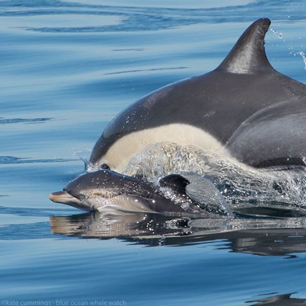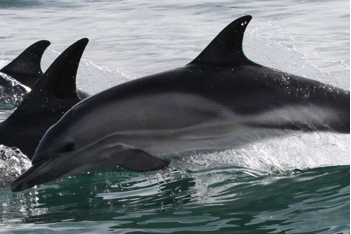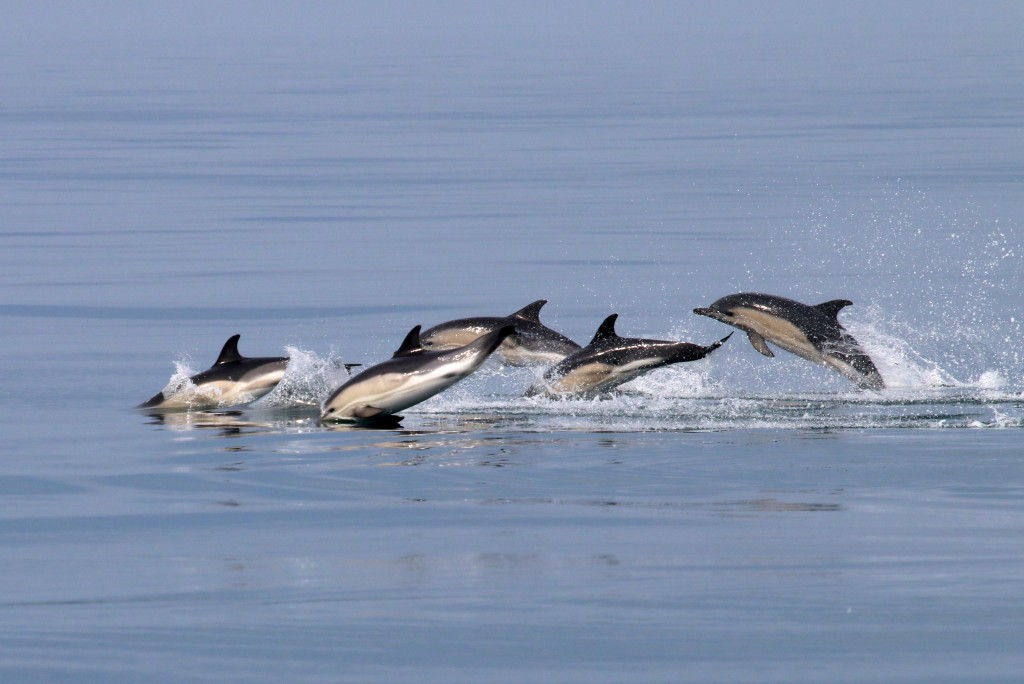Wrap up warm and see what you can spot this Autumn!
Common dolphins (Delphinus delphis) have been observed this season in many parts of the Southwest, see the map below for some of our hotspots! Although one of the most common dolphins (as the name suggests) they are one of our smallest and exact numbers in this area are currently unknown.
To help you identify Common dolphin here are some key physical characteristics that will help you distinguish them from other species. Common dolphins have a long slender body and beak, with a beautifully distinctive yellow and pale grey hourglass pattern on their side as shown above. They can measure up to 2.4m long and can weigh up to around 85 kg (equivalent to being more than 7 foot tall and the weight of an average man!). They can live to be 30 – 35 years old.
Socialising: Common dolphins love company. They are very sociable and active creatures and will often accompany boats. You may be lucky enough to see them bow-riding, using the surf in the waves created by boats or ships to propel them forward. It is thought that they do this just for fun and to catch a lift. They are fast swimmers, reaching speeds of more than 15 mph and they often perform acrobatic displays. They are also highly vocal, emitting high-pitched squeals that can sometimes be heard above the surface of the water.
Feeding: Common dolphins eat a variety of fish and will also eat squid. They will often work co-operatively to find food, herding fish into a tight ball to make them easier to target. Large sea-birds called Gannets may be seen overhead, also trying to get in on the action. Common dolphins have been observed diving for up to 8 minutes, but short dives of between 10 seconds and 2 minutes are more common. They have between 82 and 108 sharp-pointed teeth on each jaw to help them to catch their food, which will then be swallowed whole.
Calving: Common dolphins have a gestation period of 10-11 months, and calves tend to appear in either Spring or Autumn. Other females may assist the mother with the birth and also take part in ‘baby-sitting’ while the mother feeds.

- “Newborn short-beaked common dolphin! Notice the foetal folds and the floppy dorsal fin – this calf is likely less than a few days old”. Image credit: Blue Ocean Whale Watch.
Where to see them: Common dolphins are often seen by the coast and recent hotspots include Sennen Cove, Dartmouth and Rhossili Bay, where small pods of 5-12 dolphins have been seen during October. Earlier in the year in August sightings from both Devon (Prawle Point/Bucks Mill) and Cornwall (Gull Rock/Dodman Point) counted up to 60 animals at one time.

Map highlighting hot spots for viewing Common dolphins from august 2016-present. Created by Julie Hanks
Occasionally Common Dolphins can be seen in superpods where hundreds may gather. This may be due to high food availability in areas of deep water where they like to forage. In September 2014 over 1000 animals were reported off Pembrokeshire, an amazing spectacle for those lucky enough to see them.
Threats: Similarly to other cetacean species, Common dolphins are vulnerable due to pollution in the marine environment, the threat of being caught up in fishing nets, injury and disturbance from vessels and decreasing food resources due to overfishing.
See our ‘Cetaceans of South-West England’ factsheet for further information about the range of animals you may be able to see when out and about in the South-West. Happy spotting!
Please let us know what you see so we can add it to our database and continue to inform and protect these magnificent mammals.
Written by: Julie Hanks, Sea Watch Intern 2016


























